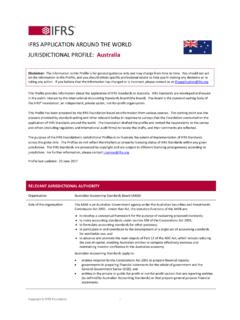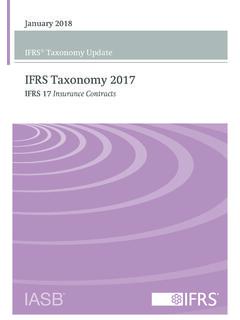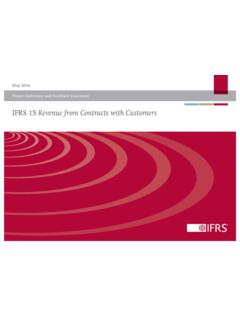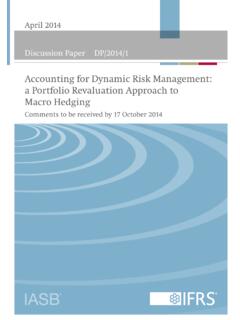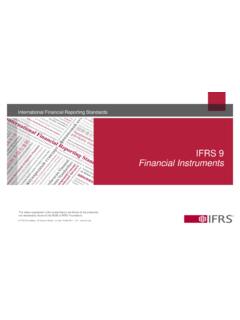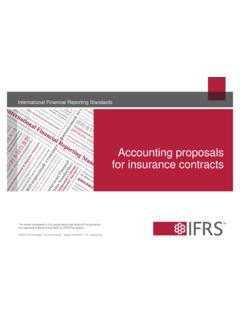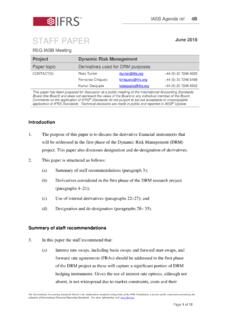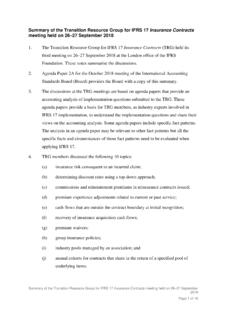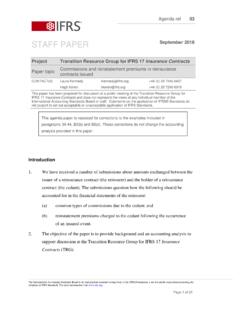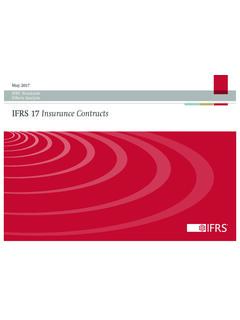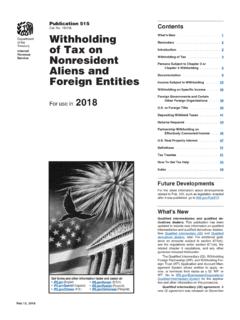Transcription of The Reporting Currency—Measurement and Presentation of ...
1 IAS 21 The Effects of Changes in ForeignExchange RatesIn April 2001 the International Accounting Standards Board (Board) adopted IAS 21 TheEffects of Changes in foreign Exchange Rates, which had originally been issued by theInternational Accounting Standards Committee in December 1983. IAS 21 The Effects ofChanges in foreign Exchange Rates replaced IAS 21 Accounting for the Effects of Changes inForeign Exchange Rates (issued in July 1983).In December 2003 the Board issued a revised IAS 21 as part of its initial agenda oftechnical projects. The revised IAS 21 also incorporated the guidance contained in threerelated Interpretations (SIC-11 foreign Exchange Capitalisation of Losses Resulting from SevereCurrency Devaluations, SIC-19 Reporting Currency Measurement and Presentation of FinancialStatements under IAS 21 and IAS 29 and SIC-30 Reporting Currency Translation fromMeasurement Currency to Presentation Currency).
2 The Board also amended SIC-7 Introduction ofthe Board amended IAS 21 in December 2005 to require that some types of exchangedifferences arising from a monetary item should be separately recognised as Standards have made minor consequential amendments to IAS 21. Theyinclude Improvements to IFRSs (issued May 2010), IFRS 10 Consolidated FinancialStatements (issued May 2011), IFRS 11 Joint Arrangements (issued May 2011), IFRS 13 FairValue Measurement (issued May 2011), Presentation of Items of Other ComprehensiveIncome (Amendments to IAS 1) (issued June 2011), IFRS 9 Financial Instruments (HedgeAccounting and amendments to IFRS 9, IFRS 7 and IAS 39) (issued November 2013),IFRS 9 Financial Instruments (issued July 2014), IFRS 16 Leases (issued January 2016)and Amendments to References to the Conceptual Framework in IFRS Standards (issued March2018).
3 IAS 21 IFRS FoundationA1221 CONTENTS from paragraphINTERNATIONAL ACCOUNTING STANDARD 21 THE EFFECTS OF CHANGES IN foreign EXCHANGERATESOBJECTIVE1 SCOPE3 DEFINITIONS8 Elaboration on the definitions9 SUMMARY OF THE APPROACH REQUIRED BY THIS STANDARD17 Reporting foreign CURRENCY TRANSACTIONS IN THE FUNCTIONALCURRENCY20 Initial recognition20 Reporting at the ends of subsequent Reporting periods23 Recognition of exchange differences27 change in functional currency35 USE OF A Presentation CURRENCY OTHER THAN THE FUNCTIONALCURRENCY38 Translation to the Presentation currency38 Translation of a foreign operation44 Disposal or partial disposal of a foreign operation48 TAX EFFECTS OF ALL EXCHANGE DIFFERENCES50 DISCLOSURE51 EFFECTIVE DATE AND TRANSITION58 WITHDRAWAL OF OTHER PRONOUNCEMENTS61 APPENDIXA mendments to other pronouncementsAPPROVAL BY THE BOARD OF IAS 21 ISSUED IN DECEMBER 2003 APPROVAL BY THE BOARD OF NET INVESTMENT IN A FOREIGNOPERATION (AMENDMENT TO IAS 21) ISSUED IN DECEMBER 2005 FOR THE BASIS FOR CONCLUSIONS, SEE PART C OF THIS EDITIONBASIS FOR CONCLUSIONSIAS 21A1222 IFRS FoundationInternational Accounting Standard 21 The Effects of Changes in foreign ExchangeRates (IAS 21) is set out in paragraphs 1 62 and the Appendix.
4 All the paragraphs haveequal authority but retain the IASC format of the Standard when it was adopted by theIASB. IAS 21 should be read in the context of its objective and the Basis forConclusions, the Preface to IFRS Standards and the Conceptual Framework for FinancialReporting. IAS 8 Accounting Policies, Changes in Accounting Estimates and Errors provides abasis for selecting and applying accounting policies in the absence of explicit 21 IFRS FoundationA1223 International Accounting Standard 21 The Effects of Changes in foreign Exchange RatesObjectiveAn entity may carry on foreign activities in two ways. It may have transactionsin foreign currencies or it may have foreign operations. In addition, an entitymay present its financial statements in a foreign currency. The objective ofthis Standard is to prescribe how to include foreign currency transactions andforeign operations in the financial statements of an entity and how totranslate financial statements into a Presentation principal issues are which exchange rate(s) to use and how to report theeffects of changes in exchange rates in the financial Standard shall be applied:1(a)in accounting for transactions and balances in foreign currencies,except for those derivative transactions and balances that arewithin the scope of IFRS 9 Financial Instruments;(b)in translating the results and financial position of foreignoperations that are included in the financial statements of theentity by consolidation or the equity method.
5 And(c)in translating an entity s results and financial position into apresentation 9 applies to many foreign currency derivatives and, accordingly, these areexcluded from the scope of this Standard. However, those foreign currencyderivatives that are not within the scope of IFRS 9 (eg some foreign currencyderivatives that are embedded in other contracts) are within the scope of thisStandard. In addition, this Standard applies when an entity translatesamounts relating to derivatives from its functional currency to itspresentation Standard does not apply to hedge accounting for foreign currency items,including the hedging of a net investment in a foreign operation. IFRS 9applies to hedge Standard applies to the Presentation of an entity s financial statements ina foreign currency and sets out requirements for the resulting financialstatements to be described as complying with International FinancialReporting Standards (IFRSs).
6 For translations of financial information into aforeign currency that do not meet these requirements, this Standard specifiesinformation to be also SIC-7 Introduction of the EuroIAS 21A1224 IFRS FoundationThis Standard does not apply to the Presentation in a statement of cash flowsof the cash flows arising from transactions in a foreign currency, or to thetranslation of cash flows of a foreign operation (see IAS 7 Statement of CashFlows).DefinitionsThe following terms are used in this Standard with the meanings specified:Closing rate is the spot exchange rate at the end of the Reporting difference is the difference resulting from translating a givennumber of units of one currency into another currency at differentexchange rate is the ratio of exchange for two value is the price that would be received to sell an asset or paid totransfer a liability in an orderly transaction between market participants atthe measurement date.
7 (See IFRS 13 Fair Value Measurement.) foreign currency is a currency other than the functional currency of operation is an entity that is a subsidiary, associate, jointarrangement or branch of a Reporting entity, the activities of which arebased or conducted in a country or currency other than those of thereporting currency is the currency of the primary economic environment inwhich the entity group is a parent and all its items are units of currency held and assets and liabilities to bereceived or paid in a fixed or determinable number of units of investment in a foreign operation is the amount of the Reporting entity sinterest in the net assets of that currency is the currency in which the financial statements exchange rate is the exchange rate for immediate on the definitionsFunctional currencyThe primary economic environment in which an entity operates is normallythe one in which it primarily generates and expends cash.
8 An entity considersthe following factors in determining its functional currency:(a)the currency:789 IAS 21 IFRS FoundationA1225(i)that mainly influences sales prices for goods and services (thiswill often be the currency in which sales prices for its goodsand services are denominated and settled); and(ii)of the country whose competitive forces and regulations mainlydetermine the sales prices of its goods and services.(b)the currency that mainly influences labour, material and other costs ofproviding goods or services (this will often be the currency in whichsuch costs are denominated and settled).The following factors may also provide evidence of an entity s functionalcurrency:(a)the currency in which funds from financing activities (ie issuing debtand equity instruments) are generated.(b)the currency in which receipts from operating activities are following additional factors are considered in determining the functionalcurrency of a foreign operation, and whether its functional currency is thesame as that of the Reporting entity (the Reporting entity, in this context,being the entity that has the foreign operation as its subsidiary, branch,associate or joint arrangement):(a)whether the activities of the foreign operation are carried out as anextension of the Reporting entity, rather than being carried out with asignificant degree of autonomy.
9 An example of the former is when theforeign operation only sells goods imported from the Reporting entityand remits the proceeds to it. An example of the latter is when theoperation accumulates cash and other monetary items, incursexpenses, generates income and arranges borrowings, all substantiallyin its local currency.(b)whether transactions with the Reporting entity are a high or a lowproportion of the foreign operation s activities.(c)whether cash flows from the activities of the foreign operation directlyaffect the cash flows of the Reporting entity and are readily availablefor remittance to it.(d)whether cash flows from the activities of the foreign operation aresufficient to service existing and normally expected debt obligationswithout funds being made available by the Reporting the above indicators are mixed and the functional currency is notobvious, management uses its judgement to determine the functionalcurrency that most faithfully represents the economic effects of theunderlying transactions, events and conditions.
10 As part of this approach,management gives priority to the primary indicators in paragraph 9 beforeconsidering the indicators in paragraphs 10 and 11, which are designed toprovide additional supporting evidence to determine an entity s 21A1226 IFRS FoundationAn entity s functional currency reflects the underlying transactions, eventsand conditions that are relevant to it. Accordingly, once determined, thefunctional currency is not changed unless there is a change in thoseunderlying transactions, events and the functional currency is the currency of a hyperinflationary economy, theentity s financial statements are restated in accordance with IAS 29 FinancialReporting in Hyperinflationary Economies. An entity cannot avoid restatement inaccordance with IAS 29 by, for example, adopting as its functional currency acurrency other than the functional currency determined in accordance withthis Standard (such as the functional currency of its parent).
